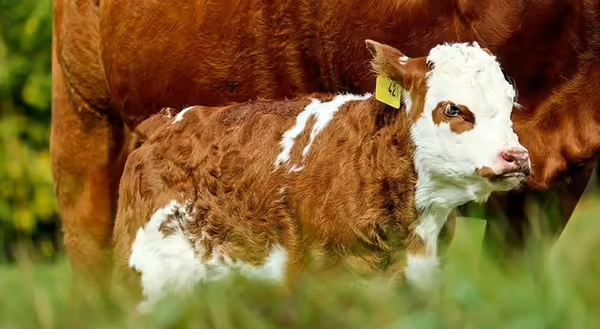
Calving season is here! Breeding decisions made the previous year are finally coming to life and are showcased through newborn calves. Although there are year-round management strategies that can impact calving season success, here are some short-term, in-the-moment calving tips for success this year:
Prepare a calving kit.
The last thing you want to be is unprepared during calving season. Having all calving equipment clean, ready to use during calving season will prevent last minute scrambling and stress. Here are some things to keep in the kit:
- Water-based lubricant
- Obstetrical sleeves
- Pulling Chains (one 60-inch or two 30-inch) with 2 handles
- Bucket/pail (with access to water)
- Disinfectant
- Iodine for calf navel treatment
- Colostrum replacer
- Tube feeder
- Towels, paper towels
- Supplements and Pharmaceuticals-As prescribed, with appropriate needle gauge and syringe.
Other notes: Having a relationship with a veterinarian can save you when in a bind. Make sure to establish a relationship beforehand. It may also be advantageous to keep a calving record book to record dates, weights, medications, and any calving difficulties that later may be used to make culling decisions.
Know when to assist.
Knowing when to assist is not always easy, especially if you aren’t sure how long a cow has been in labor. However, a good rule is if a cow is in active labor (water has broken), she should calve within 30 minutes. If 30 minutes has passed without any progress from the cow, assistance might be necessary. For first-calf heifers, generally 60 minutes is given before assistance. In the instance of a cow or calf in noticeable distress (such as rectal bleeding, calves with swollen tongue, improperly positioned calf) intervene right away. After deciding to assist, check the position of the calf (slowly correct if possible) as well as if the calf is alive and reflexive. When pulling, be sure to use plenty of OB lube and work with the cow. Pull as the cow contracts to prevent unnecessary strain.
Know when to call for help.
With time comes knowledge, but even the most experienced cattlemen need assistance occasionally. Knowing your limitations and being honest with yourself in these situations is important. Here are some situation when it might be time to call the vet:
- The calf is improperly positioned and cannot be corrected easily.
- The cow is in active labor, and you have been assisting for 30 minutes without progress.
- The calf is too large, or the dam’s pelvis is too narrow for the calf to pass.
- You are not confident or comfortable handling the situation. In a situation like this, it is better to call sooner rather than later. The longer the delay, the lower the calf’s chance of survival.
Be observant.
The first 48 hours after birth is crucial for the calf. Ensure calves are nursing in the first 12 hours. Colostrum, the first milk produced after birth, provides passive immunity from dam to calf, which will give the calf the greatest protection against disease. Calves have approximately a 24-hour window for colostrum to be absorbed. Observe the dam and calf behavior and intervene with a colostrum replacer if necessary.
Assess and act based on the weather.
In Illinois, calving season will provide an array of weather conditions. Cold, wind, and mud can make calving increasingly more difficult. If possible, allowing cows to calve indoors in a clean environment is preferred. In cases where this isn’t an option, consider adding a windbreak and removing as much mud/manure from calving areas as possible. Monitor calves for signs of hypothermia. Signs of hypothermia include body temperature below 94°F (102° is average body temperature), shivering, high pulse, increase respiration, pale cold hooves and nostrils, and low vigor. If there are signs of hypothermia, use warm blankets and heat lamps — and in desperate situations, bring the calf indoors.
Other Tips:
- Consult with a veterinarian to establish a post-natal care plan.
- Have all facilities clean and working properly prior to calving. Having to fix equipment during calving season will add extra stress to an already intense situation.
Calving season can be one of the most exciting times of the year. Don't let hurdles set you back. Be prepared and knowledgeable this calving season and watch it pay off in your calf crop.